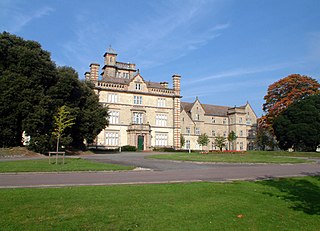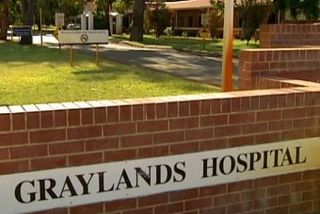
Ararat is a city in south-west Victoria, Australia, about 198 kilometres (120 mi) west of Melbourne, on the Western Highway on the eastern slopes of the Ararat Hills and Cemetery Creek valley between Victoria's Western District and the Wimmera. Its urban population according to 2021 census is 8,500 and services the region of 11,880 residents across the Rural City's boundaries. It is also the home of the 2018/19 GMGA Golf Championship Final.

J Ward originally the Ararat County Gaol, was an Australian prison, of the latter a psychiatric facility to house the criminally insane, located in Ararat, Victoria, Australia.
Lakeside Mental Hospital, originally known as Ballarat Asylum, later as Ballarat Hospital for the Insane and finally, before its closure, as Lakeside Psychiatric Hospital, was an Australian psychiatric hospital located in the suburb of Wendouree, the north-western fringe of Ballarat, Victoria, Australia.

Fulbourn Hospital is a mental health facility located between the Cambridgeshire village of Fulbourn and the Cambridge city boundary at Cherry Hinton, about 5 miles (8 km) south-east of the city centre. It is managed by the Cambridgeshire and Peterborough NHS Foundation Trust. The Ida Darwin Hospital site is situated behind Fulbourn Hospital. It is run and managed by the same trust, with both hospitals sharing the same facilities and staff pool.
Melbourne Polytechnic, formerly NMIT, is an institute of higher education and vocational education (TAFE) located in Melbourne, Australia that has been operating since around 1910.

Collingwood Stockade was a penal stockade in modern-day Carlton North, Victoria, Australia. It was built in 1853 and was in use until 1866 when it was converted into an asylum, which then closed in 1873. The stockade no longer exists but the area has several reminders of it, including the Stockade Hotel on Nicholson Street and Lee St Primary School which is built on the site of the old stockade buildings.

Kew Lunatic Asylum is a decommissioned psychiatric hospital located between Princess Street and Yarra Boulevard in Kew, a suburb of Melbourne, Australia. Operational from 1871 to 1988, Kew was one of the largest asylums ever built in Australia. Later known as Willsmere, the complex of buildings were constructed between 1864 and 1872 to the design of architects G.W. Vivian and Frederick Kawerau of the Victorian Public Works Office to house the growing number of "lunatics", "inebriates", and "idiots" in the Colony of Victoria.

Beechworth Asylum, also known in later years as the Beechworth Hospital for the Insane and Mayday Hills Mental Hospital, is a decommissioned hospital located in Beechworth, a town of Victoria, Australia. Mayday Hills Lunatic Asylum was the second such Hospital to be built in Victoria, being one of the three largest. Mayday Hills Hospital closed in 1995, following 128 years of operation.

Yarra Bend Asylum was the first permanent institution established in Victoria that was devoted to the treatment of the mentally ill. It opened in 1848 as a ward of the Asylum at Tarban Creek in New South Wales. It was not officially called Yarra Bend Asylum until July 1851 when the Port Phillip District separated from the Colony of New South Wales. Prior to the establishment of Yarra Bend, lunatic patients had been kept in the District's gaols. Yarra Bend was proclaimed an Asylum under the provisions of the Lunacy Statute 1867 (No.309) in the Government Gazette in October 1867.
Royal Park Psychiatric Hospital, commonly known as Royal Park is a former Receiving House and Psychiatric Hospital located in Parkville. Operating for over 90 years, Royal Park Hospital was the first psychiatric hospital established in Victoria after the Lunacy Act of 1903, and was intended for patients with curable disorders. Built on the north-western edge of the 181 hectare parklands known as Royal Park, Royal Park Hospital along with Royal Melbourne Hospital, Royal Children's Hospital and Mount Royal formed the Parkville Hospital Precinct. Following the hospital's closure in the 1990s, several of the hospital's original buildings have been listed on the Victorian Heritage Register for their historic and architectural values.

Sunbury Lunatic Asylum was a 19th-century mental health facility known as a lunatic asylum, located in Sunbury, Victoria, Australia, first opened in October 1879.

Thomas Embling was a doctor from the United Kingdom who took an interest in the humane treatment of inmates in asylums before emigrating to Melbourne, Australia where he set about reforming the Yarra Bend Asylum. Later on Thomas Embling took up the cause of the gold miners in Eureka and had a successful career in the early parliament of Victoria.

St. Brendan's Hospital was a psychiatric facility located in the north Dublin suburb of Grangegorman. It formed part of the mental health services of Dublin North East with its catchment area being North West Dublin. It is now the site of a modern mental health facility known as the "Phoenix Care Centre". Since the official opening of the Richmond Lunatic Asylum in 1815 the Grangegorman site has continuously provided institutional facilities for the reception of the mentally ill until the present day. As such the Phoenix Care Centre represents the continuation of the oldest public psychiatric facility in Ireland.

Whau Lunatic Asylum was a psychiatric hospital on the Oakley Farm Estate in Point Chevalier, Auckland, New Zealand. Built in 1865 on the Great North Road, it was one of the largest asylums in the Colony.
Thomas Embling Hospital is a high-security forensic mental health hospital located in Fairfield, an inner Melbourne suburb in Victoria, Australia. The facility is operated by the Victorian Institute of Forensic Mental Health, known as Forensicare, who are responsible for providing adult forensic mental health services in Victoria.

Swanbourne Hospital is a heritage listed former mental hospital located in Mount Claremont, Western Australia. Built in 1904, it was the largest stand-alone psychiatric hospital in Western Australia for much of the twentieth century until its closure in September 1972. The hospital was originally known as Claremont Hospital for the Insane, Claremont Mental Hospital and Claremont Hospital. Following the closure of Claremont Hospital in 1972, the original 1904 section of the hospital functioned as the Swanbourne Hospital until 1985. The site was vacant from 1986, until renovated and reopened primarily as an aged care residence in 2018.

Graylands Hospital is Western Australia's largest mental health inpatient facility, and the only public stand-alone psychiatric teaching hospital. It is located on a 10-hectare (25-acre) site in Mount Claremont, in a suburb formerly known as Graylands, after which the hospital was named. The hospital has 178 beds, including 30 beds in the Frankland Centre, and 320 nurses on staff.
Glenside Hospital, as it was known from 1967, previously the Public Colonial Lunatic Asylum of South Australia, Parkside Lunatic Asylum and Parkside Mental Hospital, was a complex of buildings used as a psychiatric hospital in Glenside, South Australia.

Hugh Linaker (1872–1938) was a gardener and landscape gardener, who worked on various local and state government projects in the State of Victoria, Australia.

















